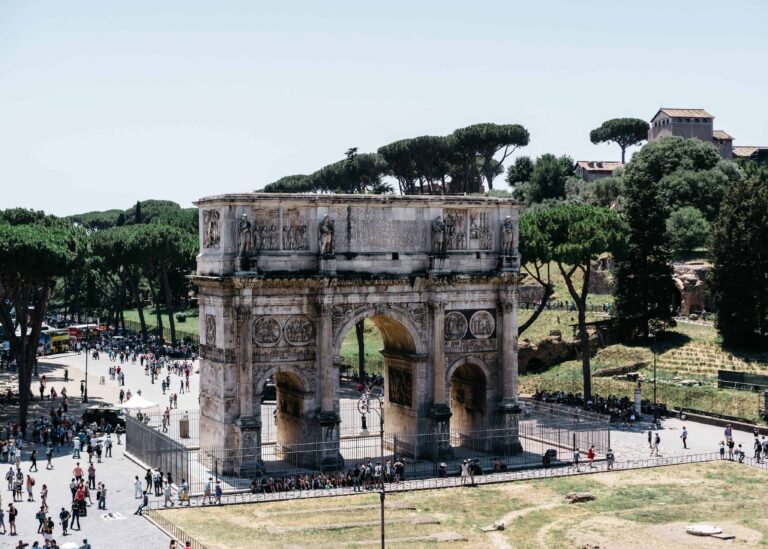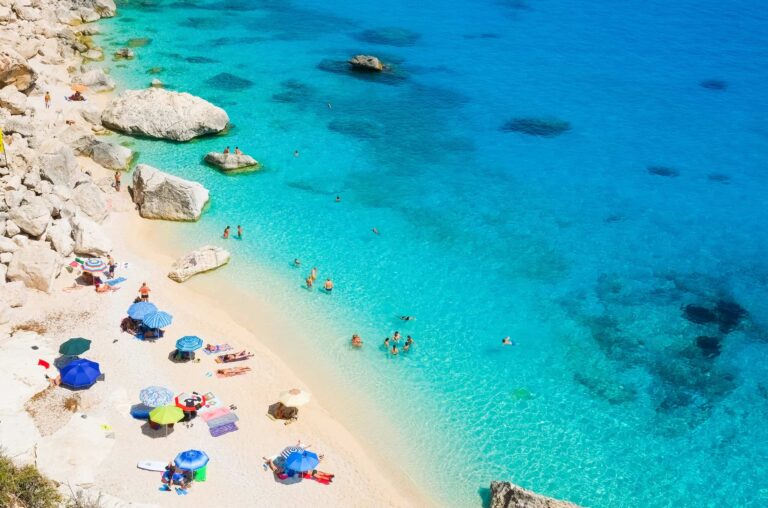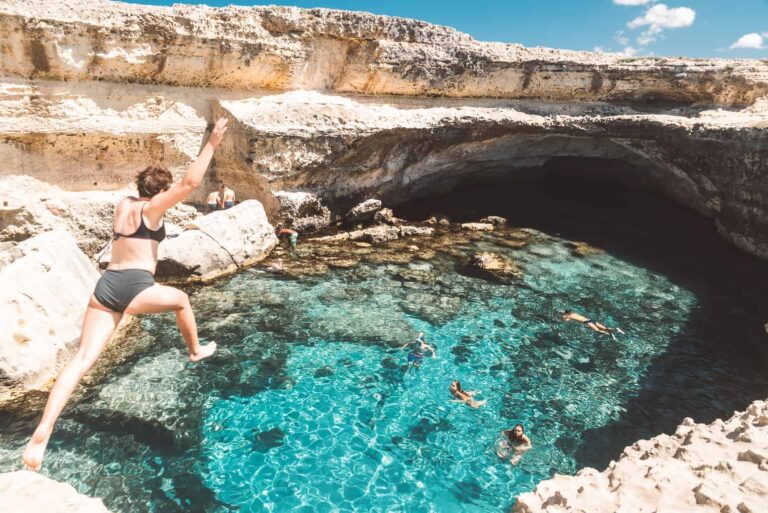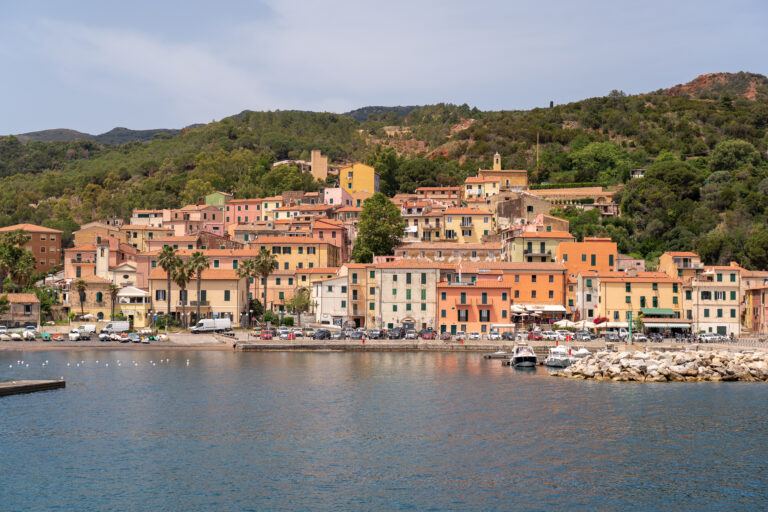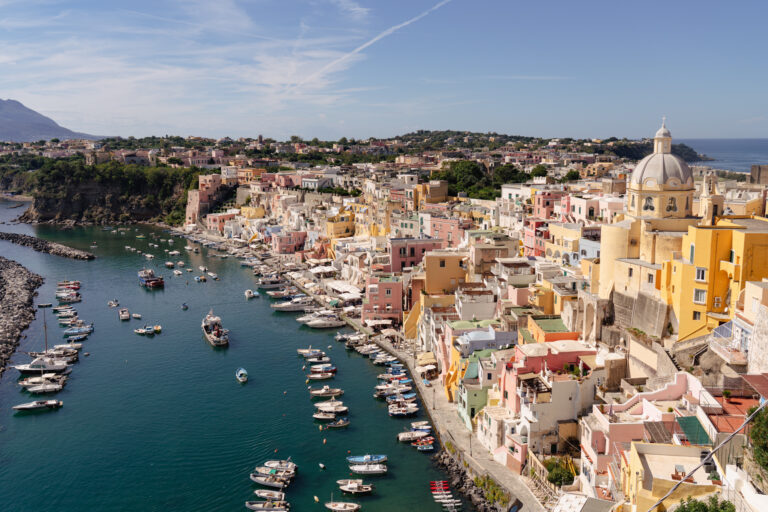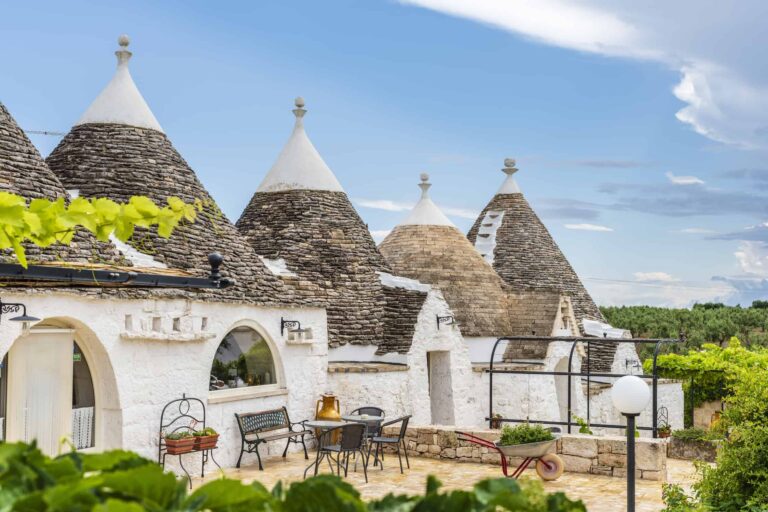Best Things to do in Trieste, Italy
Located in the northeastern corner of the Adriatic, the capital of Friuli Venezia Giulia region, Trieste sits between the sea and the karst background that borders Slovenia. It’s a melting pot in the true sense of the word – throughout history, the Romans, Venetians, Austrians, Germans, British, and ex-Yugoslavians left their traces on the city, making it a confluence of cultures.
The names of its palaces, as well as its dishes, give away clues of its multinational past. The location and the rich history of Trieste provide for an alluring mix of the Hapsburg grandeur and the Italian way of life.
If you’re looking for inspiration on what to do in Trieste, we rounded up main Trieste attractions with some local insights to dive deeper into this still undiscovered Italian city.
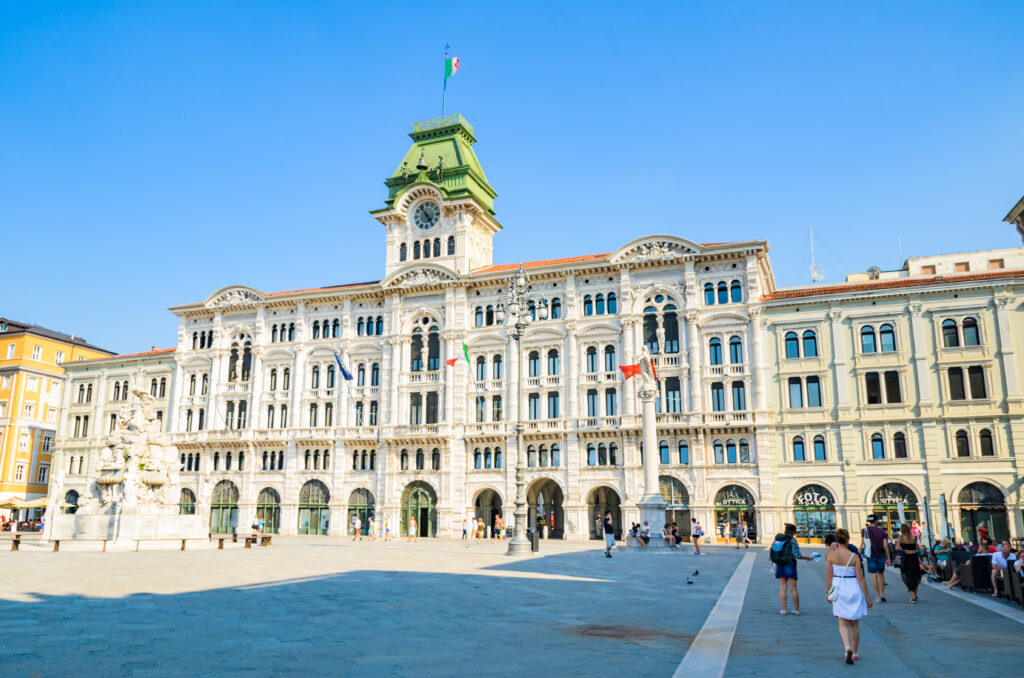
Is Trieste Worth Visiting?
The city that used to trade its goods to a stream of visitors coming from the Balkans since the late ’60s saw a decline following the breakup of Yugoslavia and the subsequent wars, but recently has been living a regeneration: its facades renovated and pristine, its traffic put in order, its food scene thriving, the streets buzzing with life- the Italian way.
Trieste was the main port of the Austrian-Hungarian Empire for more than five centuries, and the Monarchy left its mark on the city’s urban development, architecture, food, and coffee culture. Visiting Trieste Italy feels like visiting Vienna, Ljubljana, and Italy– all at the same time.
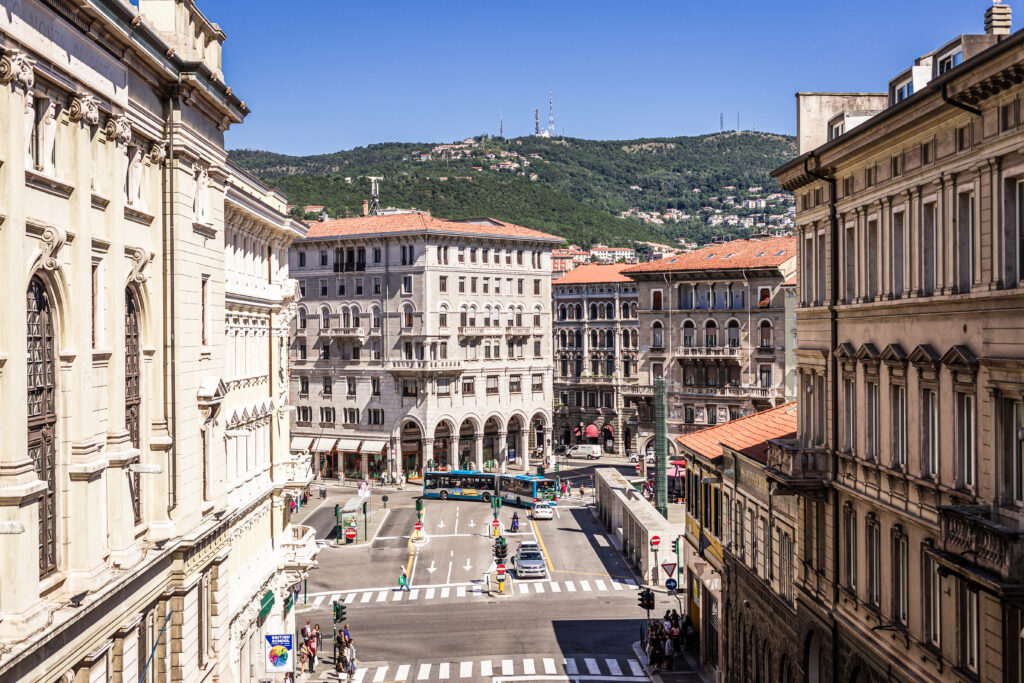
It’s a compact city with a pedestrianized center that could be explored at a relaxed pace (including a cup of coffee and a krapfen here, a fish lunch there) during a course of two days (note that many places are closed on Sundays and Mondays).
Top Things To do in Trieste
Whether your passions are food, art, history, architecture, sea views, coffee, or aperitivos, a list of Trieste things to do checks all the boxes, and this guide will cover the best of Trieste sightseeing, eating, drinking, and shopping – peppered with some day trips should you decide to explore the region more.
Experience Trieste’s unique coffee culture in one of the historic cafes
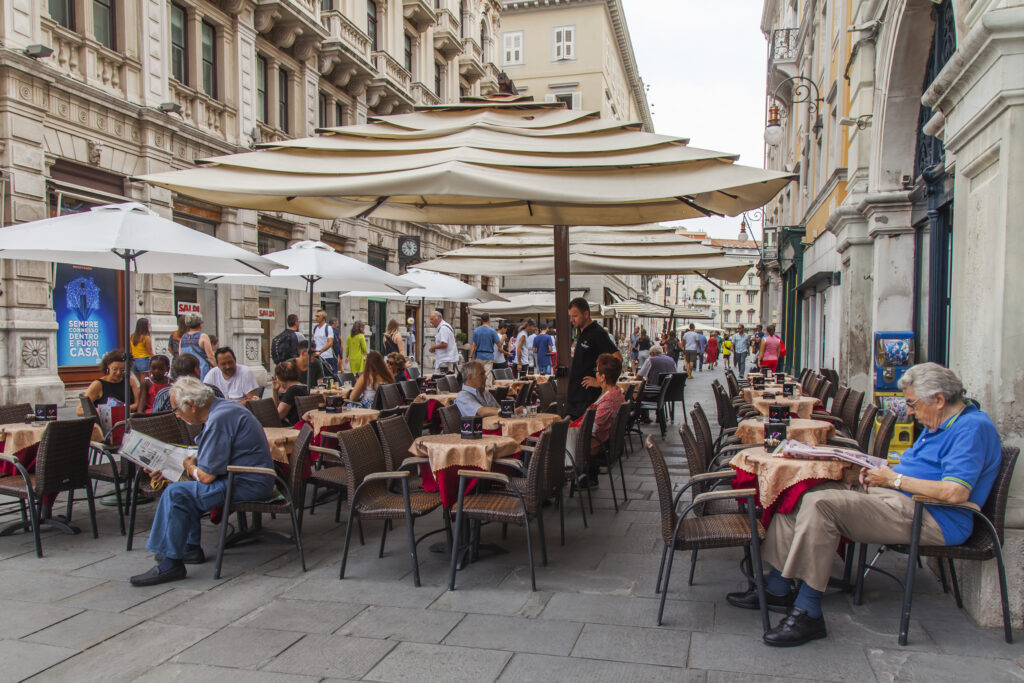
Trieste is a dream for coffee lovers: home of the nationwide famous coffee brands Illy and Hausbrandt, a port that provided the Monarchy with the precious drink, and a town renown for its traditional Viennese style coffee houses. Since the late 18th century, those grand coffee houses have been important gathering places for artists, writers, and intellectuals- some of them existing to this day, still at the heart of the city’s social life.
Caffè San Marco is a beautiful establishment dating back to 1914, its high ceilings covered with coffee leaves ornaments. It offers delicious cakes and coffee in an atmosphere recalling some other times, but what makes it even more alluring is that this cafe is also a bookshop!
The iconic Caffè degli Specchi, on Piazza Unità, was once frequented by the likes of James Joyce, and Caffè Tommaseo, the oldest cafe in the city (founded in 1825), was the one that introduced Trieste to ice cream.
Pasticceria La Bomboniera is a jewel box filled with Austrian-inspired krapfen (doughnuts), strudel, and Sacher, as well as chocolate pralines, presnitz (pastry filled with nuts, raisins, and cinnamon, a local specialty), and flaky croissants. They serve heavenly coffee, too.
Soak in the Atmosphere of Piazza Unità

The main town square is also one of the main Trieste attractions: surrounded on three sides by grand Hapsburg buildings, and open to the Adriatic on fourth, Piazza Unità is considered to be one of the largest squares by the sea in Europe.
At the beginning of the 2000s, all of the palaces underwent a renovation, and the square was newly paved and illuminated, which gave an additional charm to this already magnificent public space.
The square is home to the impressive City Hall building with a clock tower, beautiful Palazzo del Lloyd Triestino (built by the renowned Viennese architect Heinrich von Ferstel), golden mosaics-adorned Palazzo della Prefettura, and the Fountain of the Four Continents, built in the mid 18th century as a nod to Trieste’s role as a trading port.
Perch yourself on the terrace of the Caffè degli Specchi, aperitivo in hand, for people watching – as Piazza Unità is undoubtedly the social hub of the city.
Take a Stroll Down the Canal Grande
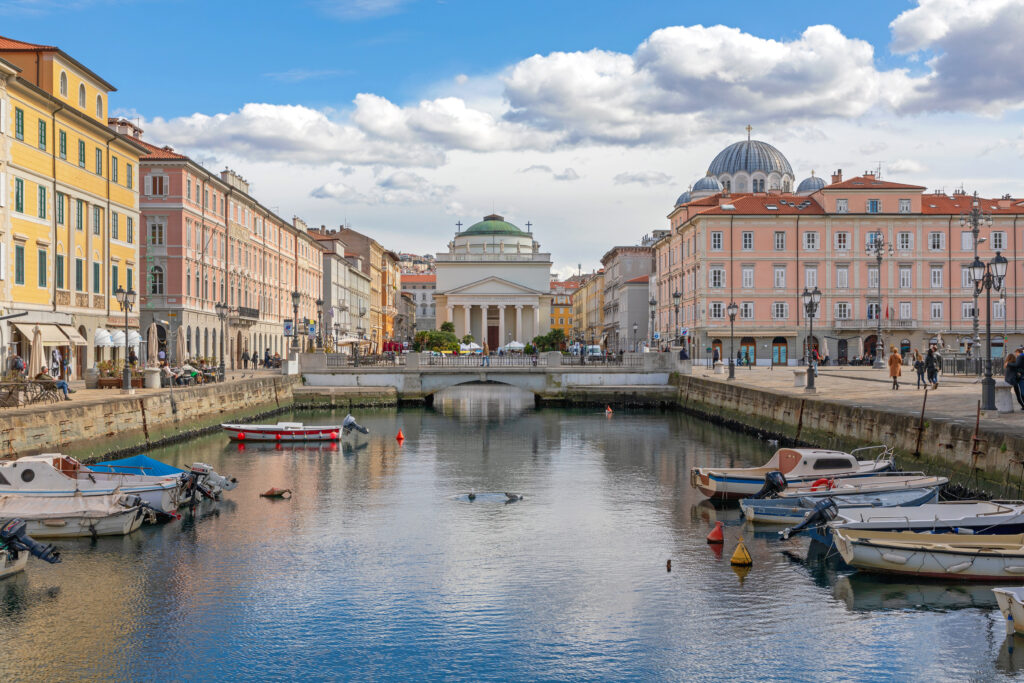
One of the most beautiful places to visit in Trieste is the iconic Canal Grande, with picturesque boats and the surrounding palaces reflecting in the water (such as the wonderful Palazzo Gopchevich, adorned with geometrical shapes).
Enjoy the view of the neoclassical Sant’ Antonio Tramaturgo church, dominating the scene at the end of the canal, and the blue domes of the Serbian Orthodox Church of San Spiridone from the Ponte Rosso bridge.
The canal was built in the mid 18th century on the spot of the former salt marshes so that the boats could sail and unload their goods directly into the city.
You can sit at the terrace of one of the bars, buy fresh fruit, vegetables, and flowers in front of the Sant’Antonio church. And if you visit in December, there is a lovely Christmas market with stalls grouped around the canal and the surrounding streets.
Climb up to Castello di San Giusto
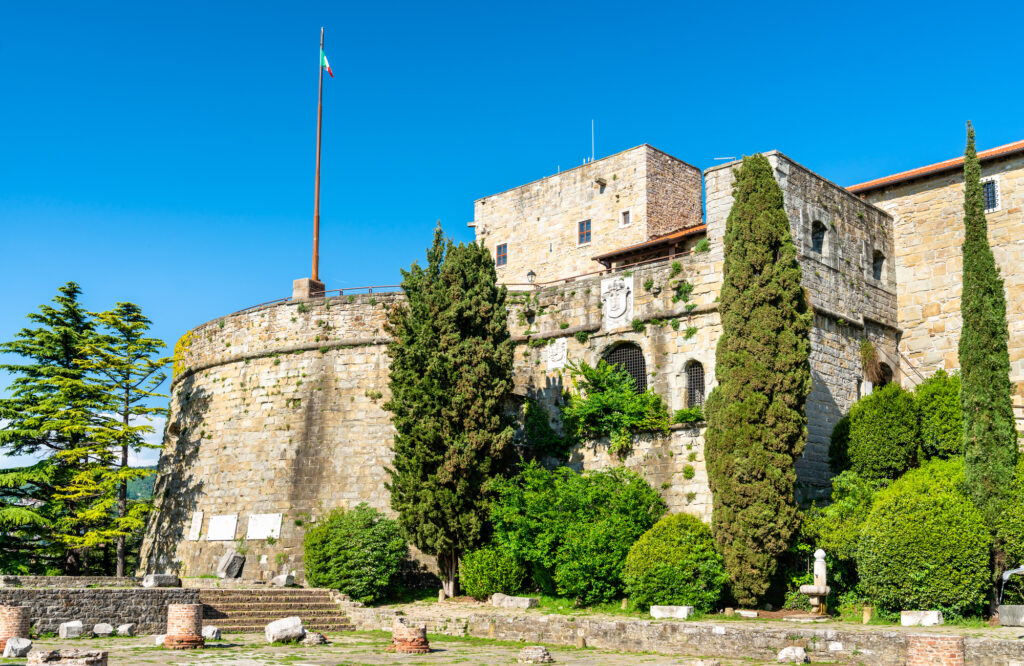
The Austrian Empire built this triangular fortress on a hill above the center between 1468 and 1636, as a seat of its Captain, and to provide protection for the city. Its three corner bastions were built in three stages during the 16th and 17th centuries, which resulted in different architectural designs of each bastion, dictated by the defensive techniques of the times.
One of the best things to see in Trieste is the incredible panoramic view of the city and the Gulf of Trieste that opens up from its walls. Next to the fortress is the San Giusto Cathedral – its austere brick exterior hides marvelous mosaics in the apses dating back to the 12th and 13th centuries, evoking the much earlier mosaics of Ravenna.
You can either walk to the top, or catch a bus No. 24 at one of the stops in the city center (at Piazza della Libertà, Rive – the waterfront, or Via Mazzini).
Take a Walk Along the City’s Waterfront
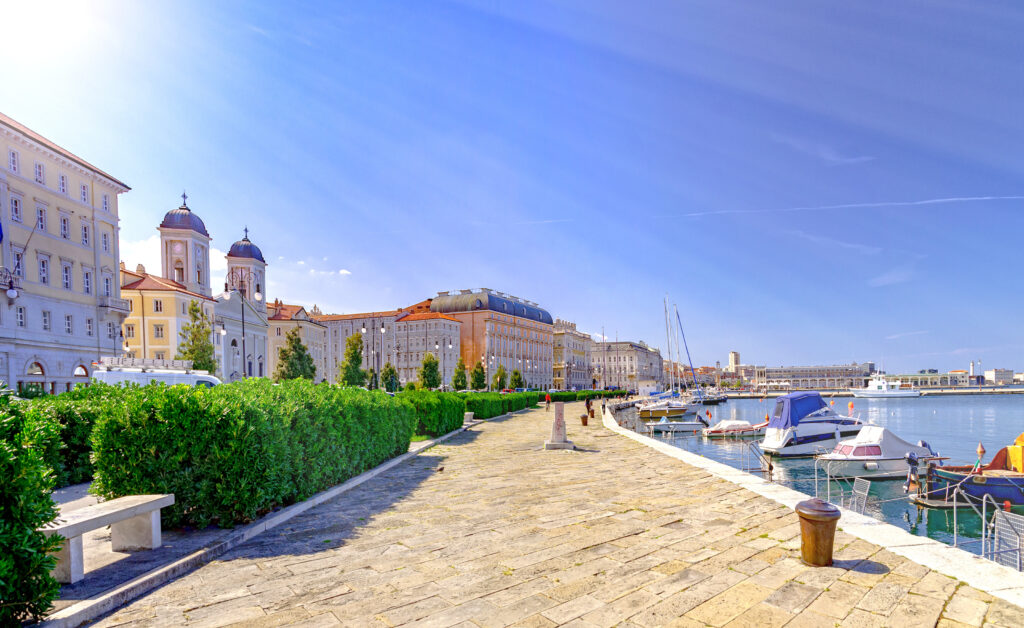
Trieste’s waterfront, or “rive” in Italian, flanked by the 19th-century warehouses and palaces, is a wonderful place to soak in the view of the gulf, and the light signals coming from Faro della Vittoria lighthouse in the evening. Don’t miss the sunset from the Molo Audace walkway, projecting 246 meters into the sea, a place regularly frequented by the locals.
Directly at the waterfront is the grand former fish market, built in 1913 by the architect Giorgio Polli. Its vast basilical layout and large glass windows made it a perfect gallery space for modern and contemporary art – called Salone degli Incanti, it regularly hosts interesting exhibitions.
For food shopping in Trieste, walk to the nearby Eataly, the worldwide famous food hall chain, situated in a beautifully renovated former warehouse. Both buildings, the warehouse, and the former fish market were a part of the larger waterfront regeneration plan. Enjoy the smartly arranged and packaged Italian delicacies with the backdrop of the rocking boats in the marina as seen through its large glass walls.
Explore the Best of Italian 20th-century Art in Museo Revoltella
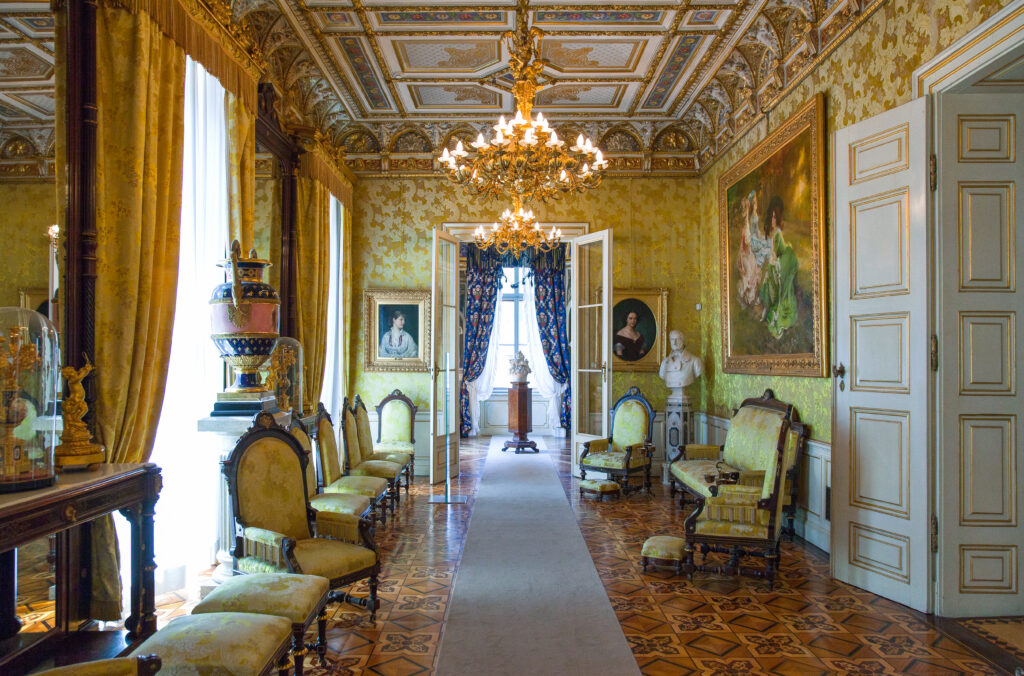
Museo Revoltella is a modern art gallery founded in 1872 by baron Pasquale Revoltella, who bequeathed his neo-renaissance 19th-century palace and his art collection to the city of Trieste. The collection includes works of art by the most prominent Italian 20th-century artists, such as Giorgio de Chirico, Giorgio Morandi, Marino Marini, Lucio Fontana, and Carlo Carrà.
Along with his palace and his art collection, baron Revoltella also bequeathed a significant revenue to the museum, which allowed the collection to grow – the museum expanded to the adjacent Brunner palace in 1907. In the summer months, its panoramic terrace functions as a bar.
Refresh in the Giardino di Villa Revoltella
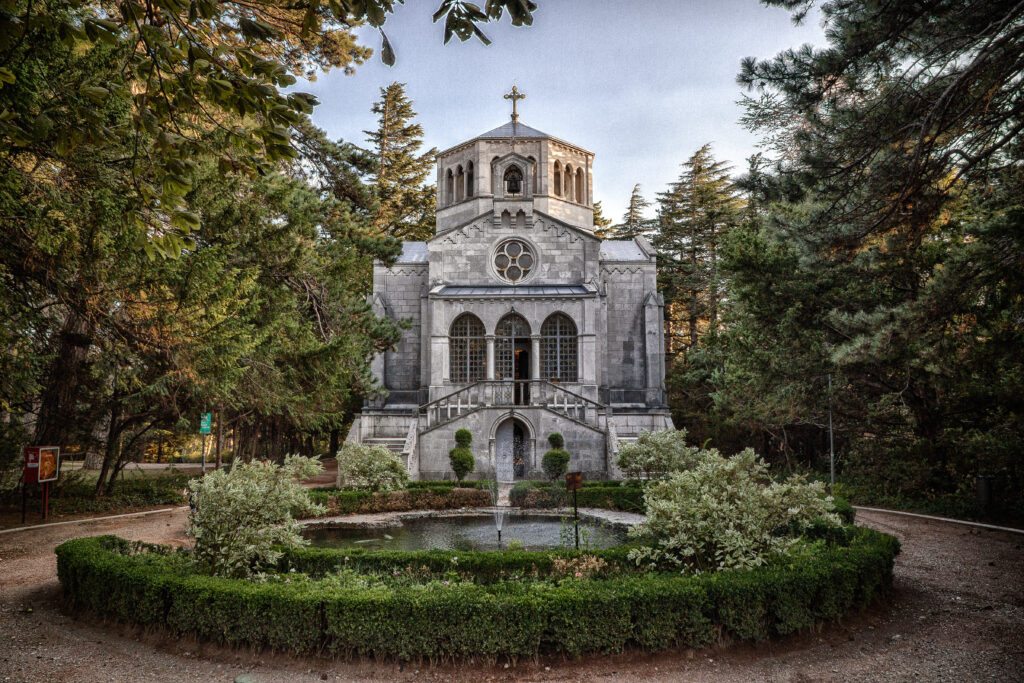
One of the undiscovered places to visit in Trieste is the park of Villa Revoltella (once belonging to the same baron Revoltella mentioned above, however, not at the same location as the museum). The garden is perched on a hill outside the city center, a lovely green refuge with views of the coastal town and the gulf.
Its 50,000sqm are planted with evergreen ornamental shrubs, conifers, a collection of ancient roses, and large, centuries-old trees. The baron also built a Swiss chalet, a stone church made of local karst, stables, service buildings, and a cast-iron greenhouse on the premises – and ultimately bequeathed the property to the city of Trieste with the clause that the garden should stay open to the public.
Villa Revoltella garden was classified as one of the most beautiful parks in Italy by the National Competition of Parks and Gardens sponsored by the Ministry of Cultural Heritage and Activities. To get there, catch the bus No. 25 from Corso Italia in the center, direction Cattinara (Ospedale).
Go Antique Shopping
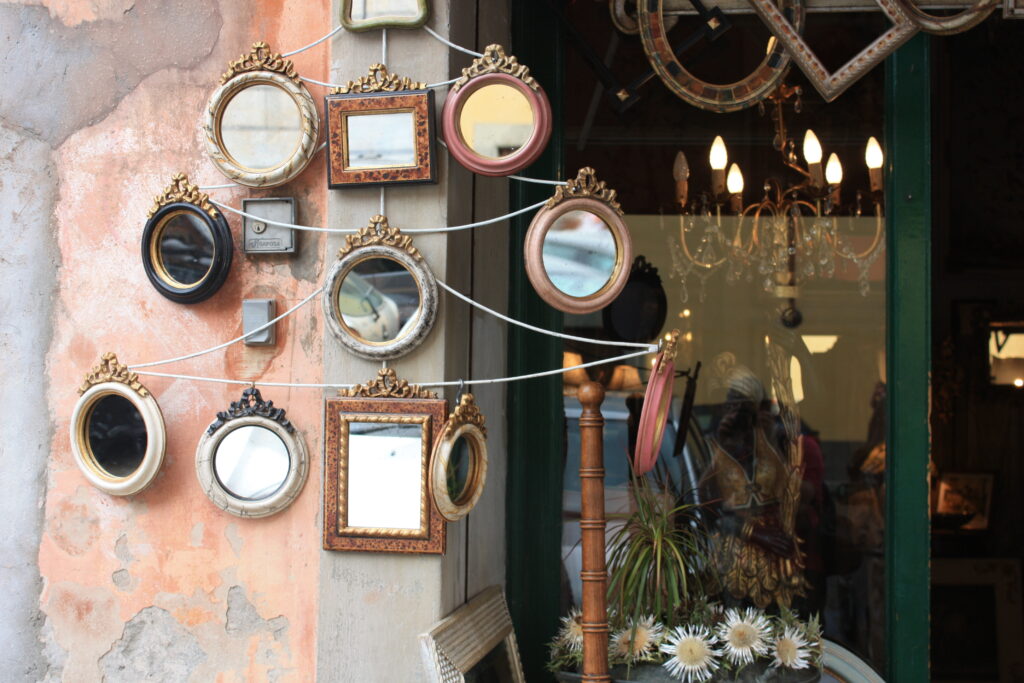
Wheater you’re looking for vintage furniture, light fixtures, books, tableware, clothes, or Christmas ornaments, Trieste has plenty of antique stores concentrated around Piazza Unità. Delikatessen in Via Felice Venezian is one of the city’s flagship antique stores, offering furniture, vintage suitcases, lamps, postcards, with a culmination in December when it spills out an Aladdin’s cave of vintage Christmas baubles.
There are a couple of more vintage stores around the block enclosed by Via Felice Venezian, Via Cadorna, and Via dell’Anunziata. Another area to get lost in the rows of antique books, linen, and beautifully restored furniture, are the narrow streets of the Jewish Ghetto behind Piazza Unità and Piazza della Borsa.
Rigatteria di Laura e Claudio Pinto Sas and Libreria Achille Sas are the real treasure coves, but there are plenty of other stores to lose an hour or two in a blick of an eye.
Explore the Roman History of Trieste in Teatro Romano
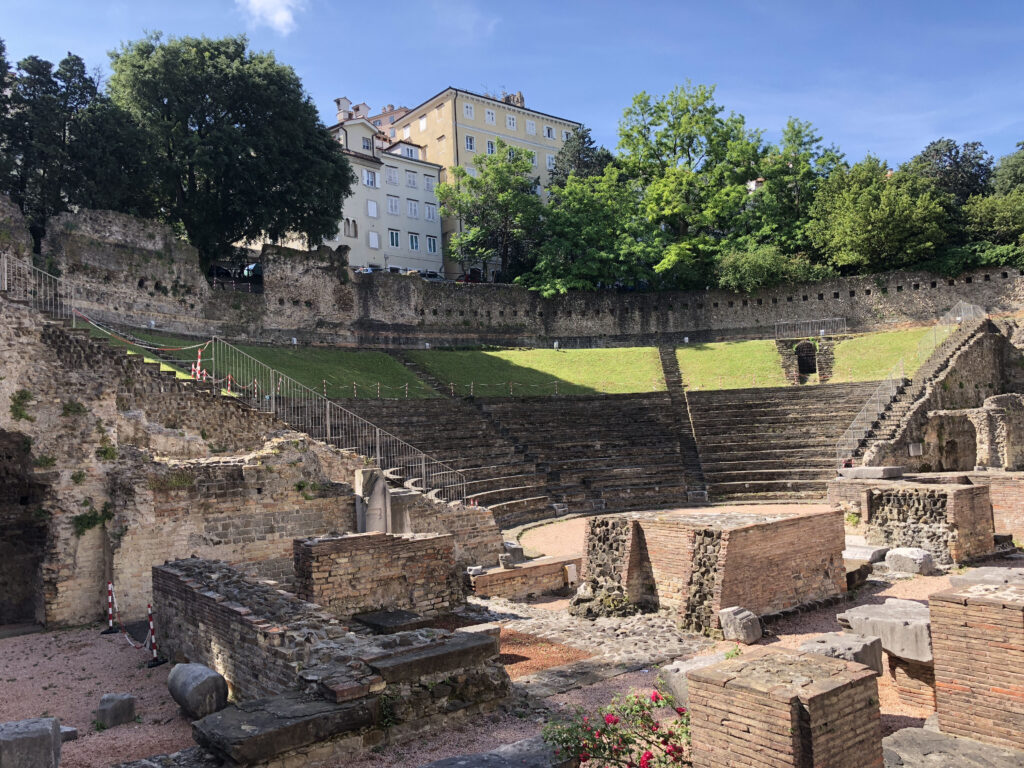
A couple of minutes walk from Piazza Unità, smack in the middle of the city, is the Roman theatre dating back to the 1st and 2nd centuries A.D.
It was hidden away for centuries and only excavated in 1938 during the demolition of a part of the medieval structures of the old city. Restored and partly reconstructed, today this 2000-year-old-theater is still being used for concerts in the summer months!
Interestingly, at the time of its construction, the theatre sat directly by the sea – today, the waterfront is drawn almost 400 meters away, on the other side of Piazza Unità.
Don’t Leave Without Trying th Local Delicacies in one of Trieste’s Trattorias

Tucking into the city’s rich culinary heritage is a must: a blend of Austrian, Slovenian, and Italian influences, it’s a place where you can order a Viennese Sacher-cake, as well as jota – the Slovenian national dish of sauerkraut and beans, and crispy fritto misto (fried fish platter- Trieste is, after all, a seaside town).
Head to Trattoria Nerodiseppia for the best fish delicacies (and some seriously good desserts), or enjoy the homely atmosphere and the traditional Friulian recipes in Trattoria Mara. Order cjalsons (thick ravioli filled with herbs, covered with butter and breadcrumbs), or Friulian frika: hearty cheese and potato hash.
Daytrips from Trieste
Conveniently located between the sea and the hills, Trieste’s location offers day trip opportunities that could satiate any taste: within half an hour’s ride from the city center, you can escape the city in a small seaside town, enjoy old aristocratic grandeur in a castle by the sea, or explore the karst landscape in a nature reserve in the city’s hinterland.
Muggia
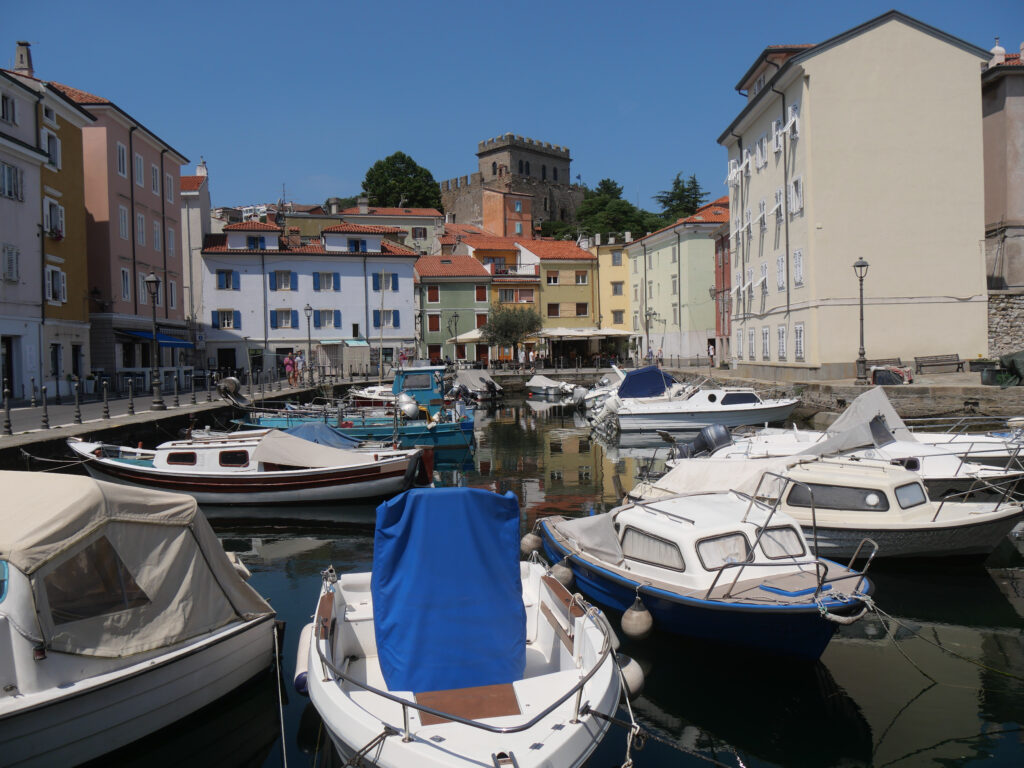
Hop on a ferry shuttle from Molo Bersaglieri for a scenic ride to the fishing village of Muggia, the only Italian town located on the Istrian peninsula. Ruled by the Venetians for most of its history, Venetian traces are felt both in the town’s architecture and cuisine.
Take a stroll down Muggia’s lungomare (the promenade), take some photos of its colorful houses and narrow streets adorned with lines of laundry drying in the sun, and then sit for an aperitivo and irresistible people-watching on the main piazza.
Castello di Miramare
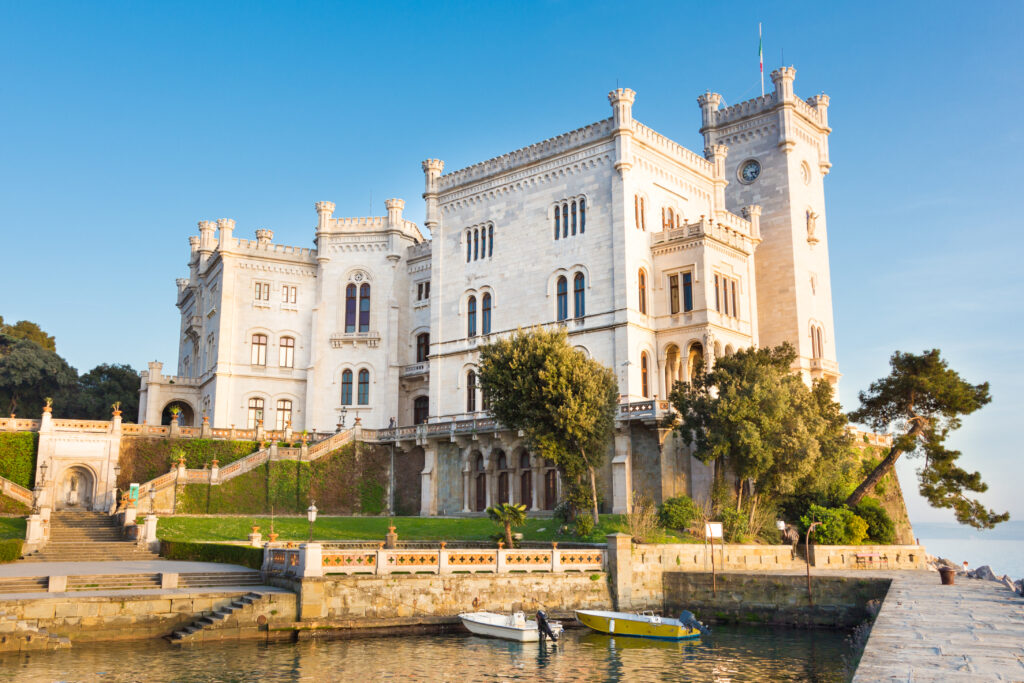
The splendid Hapsburg castle, perched on a rock above the sea 8 km from the city center, is one of the not-to-be-missed Trieste tourist attractions.
The castle and the surrounding park were commissioned by Archduke Maximilian of Hapsburg in the mid 19th century. Allegedly, the duke first noticed the beautiful promontory while sailing the coast next to Trieste.
The castle is an eclectic blend of Gothic and Renaissance neo styles, surrounded by a fantastic 22-hectare park planted with rare and exotic tree species, once a barren landscape devoid of vegetation.
You can wander the castle grounds and park without a fee or buy a regular ticket to explore the castle’s lavish interior for €10. The rooms still feature the original 19th-century furnishings. The sea surrounding the castle is a Marine Protected Area – an oasis of marine biodiversity right next door to one of the largest ports in Italy!
You can reach the castle easily from the city center by bus No. 36 from Piazza della Libertà (the main train station). Or book a day trip tour from Trieste.
Val Rosandra
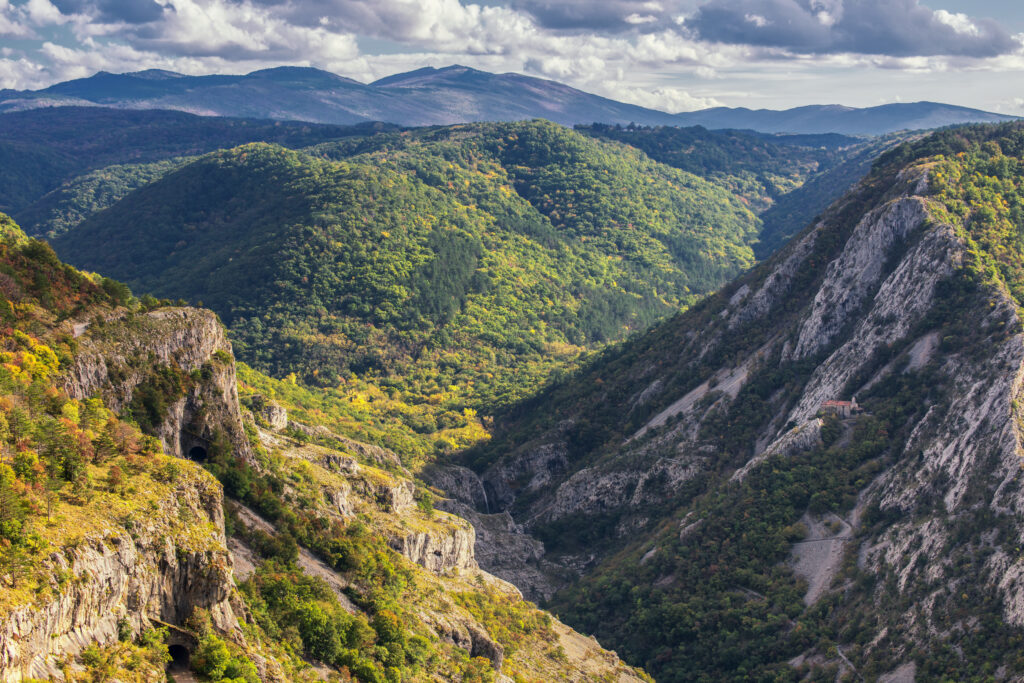
The Val Rosandra Reserve is a karst landscape (called carso in Italian) pierced by many caverns and the underground Timavo river. Covered in flowers in the spring, ideal for autumn foliage watching, it offers breathtaking vistas – whether it’s the panorama of Trieste or the scenic Rosandra stream and waterfall.
There are hiking itineraries on the official website ranging from 1 to 6/7 hours – in any case, wear hiking boots and bring enough water, as the karst landscape is not the one to leisurely stroll in your sandals. You can reach the Reserve by bus No. 40 or 41 from Piazza della Libertà to the park’s entrance in the town of Bagnoli.
Short holidays in Trieste will offer an insight into the city that took the best thread from each culture that shaped it and has woven them into something specifically its own. There are plenty of things to do in Trieste for those willing to unravel this unique yet relatively undiscovered region of Italy.

